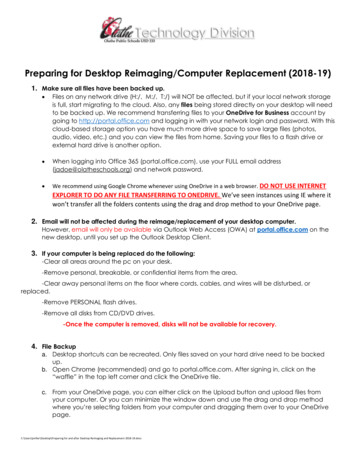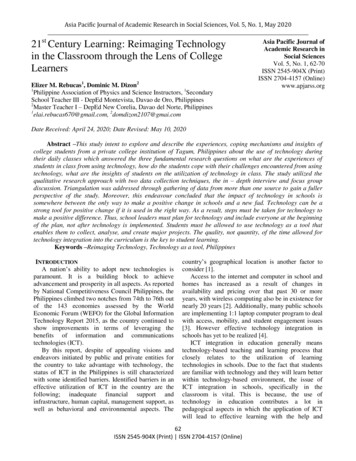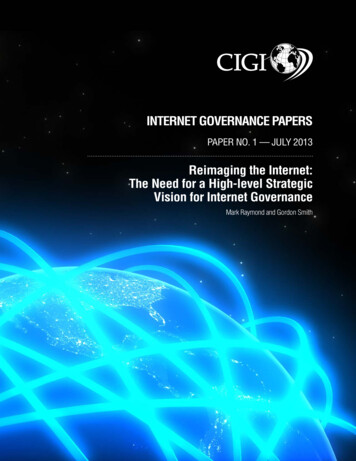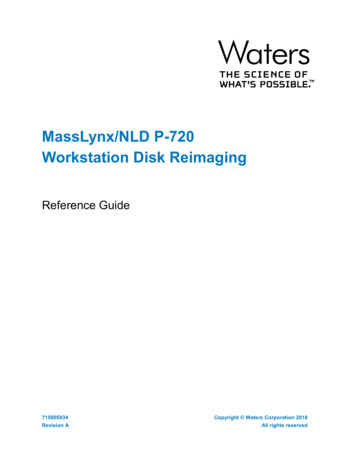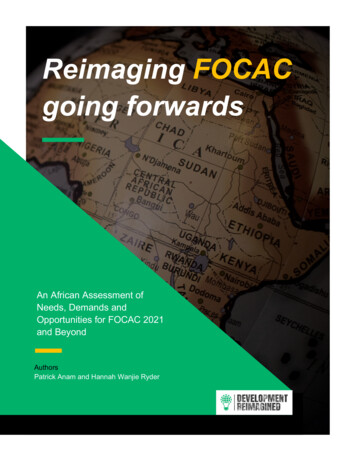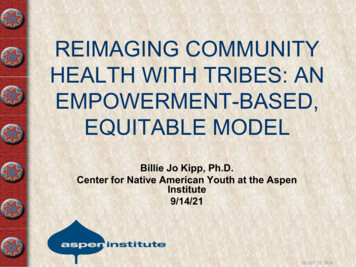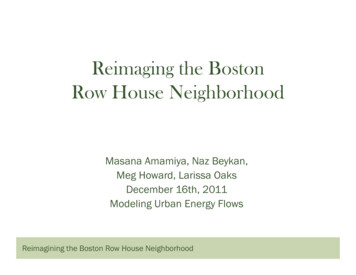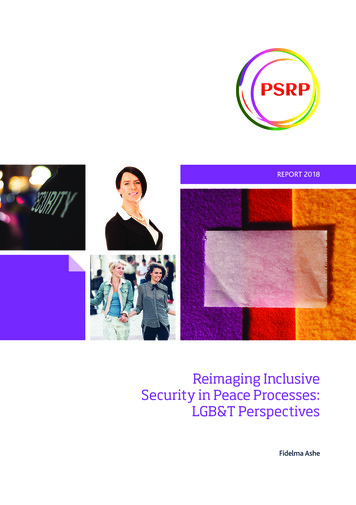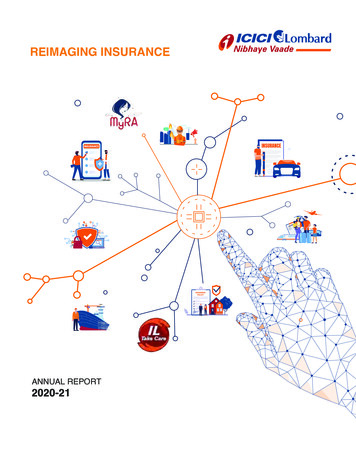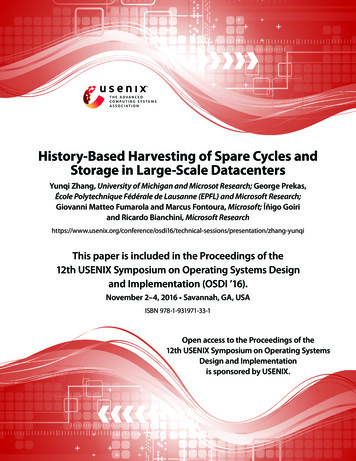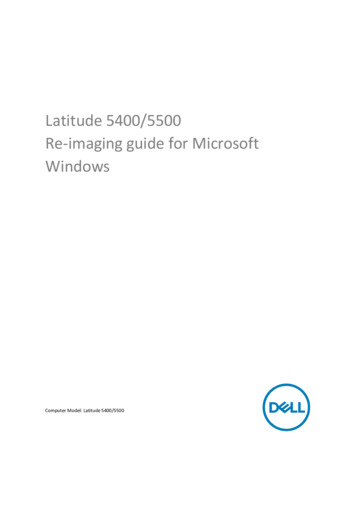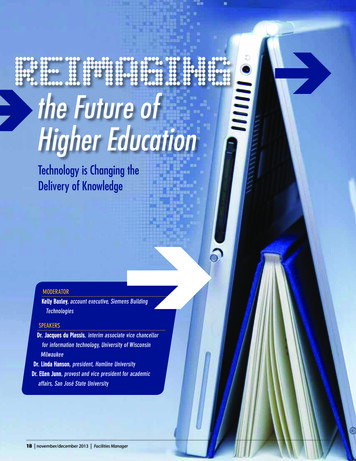
Transcription
REIMAGINGthe Future ofHigher EducationTechnology is Changing theDelivery of KnowledgeMODERATORKe lly Baxley, account executive, Siemens BuildingTechnologiesSPEAKERSDr. Jacques du Plessis, interim associate vice chancellorfor information technology, University of WisconsinMilwaukeeDr. Linda Hanson, president, Hamline UniversityDr. Ellen Junn, provost and vice president for academicaffairs, San José State University18 november/december 2013 Facilities Manager
“Higher education is at a crossroads,” Kelly Baxleydeclared as he introduced the plenary session atthe APPA 2013 conference in Minneapolis lastAugust. “The sector urgently needs to innovatebecause becoming a savvy user of technology is now a requirement, regardless of industry or career path. The vast proliferation of mobiledevices demands that education become green, global, and mobile,” hesaid. “Emerging areas such as cybersecurity, big data, predictive analytics, and the Internet of everything are generating new challenges and opportunitiesfor many industries, including higher education.” Further, he noted that the advent ofmassive open online courses (MOOCs) has introduced new dimensions to discussionsabout online and physical campus experience.In their presentations and their responses during the Q&A session that followed,the speakers discussed the impact of these technologies on higher education, includingtheir own institutions’ challenges and responses. Repeatedly, they stressed the need foran integrated approach, from the ground up, with academic, technology, and facilitiessides of the house collaborating to achieve sustainable institutions and thriving communities of student-centered learning.CONTINUOUS TECH INNOVATIONSBy AnitaThe Internet and constant advances in technology have radically changed highereducation delivery. These advances are moving the industry to evaluate not only whatnew facilities are needed and how to equip them, but also what facilities are less indemand and how to repurpose them.Tech upgrades are ubiquitous. For example, Provost Ellen Junn reported that San JoseState University (SJSU) has tripled Wifi access and has plans for 5l classrooms equippedfor interactive HD remote instructors and guest lecturers, lecture capture, and otherfeatures. All classrooms, conference rooms, and offices can use WebEx teleconferencing,and there is also a VOIP (voice over Internet protocol) phone system. In April 2013, theChronicle of Higher Education named SJSU President Mo Qayoumi (an APPA Fellow)among the top ten technology innovators in the United States.However, President Linda Hanson of Hamline University pointed out that, evenas they upgrade, many institutions find that they no longer need to supply a variety ofequipment they had previously provided, such as desktop and laptop computers, videoproduction studios, etc. Both SJSU and Hamline stress a new practice for students:BYOD—bring your own device. In fact, Hanson noted that the variety of cutting-edgedevices that students bring to campus is driving change. “This is a change that all institutions of all sizes, staff sizes, and budgets have to deal with,” she said. “Students expectthe colleges to have the resources to support the devices they bring—and to supporttheir learning outcomes 24/7/365.”Hanson explained that Hamline’s response is to pursue an integrated model, withfacilities and tech departments creating what is needed for the student learningoutcomes they want. This includes providing mobility (students can be anywhere,learning on any device), flexibility (students can access course materials, groupwork, etc.), sufficient capacity, and virtual and physical support.In addition, Hanson said, the university is expected to help facultysupport these devices. But she admitted that there were a number ofolder faculty members who believe their job is to know their disciBlumenthalpline and interact personally with students, and not to have to learnnew technology, a task for which they have no time and are not paid.Facilities Manager november/december 2013 19
BYOD also directly affects the university’s built environment.For example, Junn notes that these days, every college no longerneeds to have its own physical computer lab. Further, Hansonsays that Hamline’s law library comprises many shelves of volumes that are little used because students use online databases.“So what should the physical library look like in the future?” sheasked. Whatever the eventual answer, Hanson said that facilitiesneed to “demonstrate a commitment to sustainable learning andliving environments.” Whether new or renovated, they “cannotbe imagined without planned integration and adequate investment to sustain the rapid pace of changes in technology.”New digital technology can also offer new communicationsmodels that can transform the functioning of the entire campus,according to Jacques du Plessis of the University of Wisconsin20 november/december 2013 Facilities ManagerMilwaukee. He calls the field “intellification of information,”which uses an “expanding array of sensors that can measureand be aware of so much. All this information is digital, so itcomes in and is stored . This information is understood, and[therefore] when something happens, it can trigger somethingelse” (such as turn off an automated sprinkler system when sensors send the message that it is raining).BUILDING TOMORROW’S LEARNING SPACESThe accelerating use of technology raises major issues regarding physical plant: How do you construct a building for a schoolof science, for example, when the institution does not knowwhat size or configuration it will need in just a few years?We need “faculty-designed and discipline-specific, technologically enabled classrooms that maximize usage efficiency,”Hanson said. To achieve this, she said, there must be a closeconnection between the faculty, who know how they want todeliver their courses, and the sides of the house that can help usdesign it.Many changes havealready occurred. Hansonpointed out that comDr. Ellen Junn, provost andputers and technologyvice president for academic affairs,enabled modeling havereplacedtasks that used to beSan José State Universitydone in labs and classrooms.“More and more professors donot want theater-style lecturehalls,” Junn said, “but rather want
furniture that can roll, allowing small group work, and they wanttech-enabled classrooms.”“Flexible facilities enable high-impact student learning,” Hanson said. “We know that; we can quantify that.”Junn suggested that facilities managers learn about such impressive examples of this new approach as SCALE-UP (StudentCentered Active Learning Environments with Upside-downPedagogy; see http://scaleup.ncsu.edu/), aimed at large introductory science courses that had previously been considered places toweed out students who wouldn’t succeed as majors in the subject,rather than serious learning opportunities for non-majors.HYBRID COURSES—PARTONLINE, PART CLASS/LABAlthough MOOCs are much in the news,the panel also discussed other options along thecontinuum, including hybrids and limited-availability online for-credit offerings.Junn described two programs, both in theirinitial stages. First, in collaboration with MIT,San Jose State is testing a hybrid version ofone of original courses designed by edX (theHarvard/MIT MOOC). The course is the sameSJSU’s Electrical Engineering 98, Circuitsand Electronics course, an upper division classrequired for all engineering majors. The SJSUformat has online components (short videos,quizzes, virtual lab, textbook) and in-class smallgroup work, individual/group quizzes, and minilectures. Junn reported that the traditional classroom format averaged a 59 percent pass rate. Infall 2013, the first time the hybrid Edx version was taught, thepass rate was 91 percent. The spring 2013 pass rate was also over90 percent.Junn noted that the University of Florida has experimented foryears with different formats, and studies have found that studentsprefer the hybrid model. “They are still interested in the face-toface aspect of the university experience,” she said.ONLINE COURSESIn its second pilot, San Jose State is collaborating with another MOOC provider, Udacity, to offer completely online courses(with support from the Gates Foundation and the NationalScience Foundation to study the data). The spring 2013 offerings had more than 200 students, with a focus on disadvantagedstudents and included remedial math and introductory coursesin algebra and in statistics. The summer 2013 offerings expanded the limited enrollment to 2,000 students from the UnitedStates and abroad and offered remedial math and introductionsto algebra, statistics, psychology, and computer programming.SJSU is analyzing the results and will recommence courses inspring 2014.The summer courses were offered in the extension section ofthe university. Unlike MOOCs, they were not open to all, theycarried university credit, and they cost 150. Junn suggestedthat this approach, given the possible volume of students whomight want to take credit-carrying courses online could raisesignificant revenue and help students take courses toward graduation that they could not otherwise fit in.However, Junn warned that the transition to online coursework is not seamless. “Just because [students] know how to interact with some kinds of media does not mean they are digitallyliterate,” she said, “nor do students understand what it is like tolearn in a completely different modality. Learning in an online courseis radically different from taking aDr. Jacques du Plessis, interimassociate vice chancellor forinformation technology, University ofWisconsin Milwaukeeface-to-face class. So we have foundwe also have to educate even our digitally native students about how toapproach and change behavior on anonline course in order to succeed.”Du Plessis of UW Milwaukeediscussed the importance of completely online education forremote regions, as well as for people who can learn withoutclassrooms. He said that the University of South Africa, with350,000-plus distance-learning students, is working on a newmodel of education, which would require only a tablet—onwhich all textbooks would be loaded—a cell phone, and a solarpanel to charge the devices. He also noted the strong trendtoward competency-based education and testing. The idea thatpeople can learn without classrooms is “a very inconvenienttruth,” he said, but it is important to work out a way to be “receptive to people who can learn on their own and provide themwith a way in which they can verify their skills.”PLANNING—MORE DIFFICULT THAN EVERPlanning has always been important in facilities management,but with the radical changes taking place—and undoubtedlywith many more to come—what happens to the idea of masterplanning? Hanson listed numerous challenges, including how todesign spaces for future technology and determine the balancebetween physical and virtual learning spaces, as well as amountsto spend on them.Facilities Manager november/december 2013 21
Master planning tries to predict the future, but perhaps it’srather a matter of predicting direction. For example, Junn saidthat today, SJSU is responding to the new fields that did notexist 10 or 20 years ago (e.g., cybersecurity, big data, learninganalytics). She is responding by hiring faculty across differentcolleges. Also the university plans to expand the number of gradstudents in the STEM subjects (science, technology, engineering, math), “so we can expect to expand faculty, labs, equipment,and office space,” she said. However, she admitted, “We knowthere will be new fields of study that do not exist today that willexist 10 or 20 years from now. How do we plan for them?”Besides, Hamline’s Hanson noted some pitfalls of the formal,long-term planning process, which can take 18 months and endby losing sight of the initial vision. Further, the plans can bederailed by unforeseen events. “We’ve started to think of it asa rolling plan,” she said. “It must always be flexible, constantlyfactoring in impediments.”Du Plessis suggested that an important step to anchor anyplanning process is to ask, “What is the ‘form factor’ of theinstitution? How does the form limit or support you in servingyour clientele? Define your clientele (rich/poor, particular discipline, ethnic groups, gender, etc.) and define your big purpose.If you focus on the form factor you have,” he said, “you canunderstand strategically who you are and where to direct yourfuture. “Do not try to emulate an institution that does not shareyour form factor,” because that could result in unwise spending,among other things.Also, du Plessis said it was important to pick up trends anddirections early. “Be where you know you need to be—not whatyou do well,” he said. “Listen to Darwin. Who survives? Whoever adapts best.”No speaker could avoid the problem of current and futurefunding, especially now, as Junn pointed out, with 46 states22 november/december 2013 Facilities Managerdecreasing their appropriations for public higher education,moving toward zero. However, du Plessis warned, “It is notsustainable to put the burden of financing on students,” whosenumbers, in any case, are dwindling in the United States. Henoted more creative approaches such as compacts to shareresources with other campuses and partnerships with privateinstitutions that would, for example, contribute to building alaboratory and then use the facility as well.EVERYONE AT THE TABLEThe changes and challenges multiply: tech-enabled classrooms; ever-smarter devices; continuous support requirements;ever-increasing capacity, flexibility, and access. “Not changing isnot an option,” Hanson said. “We cannot sit on our laurels, evenof what we did 18 months ago.” Further, she said that everyone,from governing bodies to faculty, funders, students, and alumni,must understand that “we are in and of that very porous insideof-academia/outside-of-academia world.”The speakers agreed that the way to respond lies in an integrated model: Everyone from all sides of the house—academic,tech, and facilities—should have a place at the table and shouldhave knowledge of needs and resources. In one example of closercoordination, Junn noted that many schools now have a separateacademic technology component, concerned specifically withusing technology in academics, in addition to the institution’s information technology services center,Dr. Linda Hanson, president,often under the chiefHamline Universityfinancial officer.Du Plessis advisedthe tech and facilitiesdepartments to educatethemselves about how their contributions could improve studentlearning. “Don’t just sit back and say [to the education leadership], ‘Tell me what you want and I’ll do it.’ That is abdicatinga very important part of your responsibility,” he said. Facilitiesmanagers must be able to debrief the education leaders about allthe possibilities. “Show them your expertise in knowing what’sout there,” he said. “You’ve got to deliver some pieces [to whichthey can respond], ‘Ah, that gives me an idea.’ And then, theconversation starts.”Anita Blumenthal is a freelance writer based in Potomac, MD. Shecan be reached at anitablu@earthlink.net.A video of this plenary session is available atwww.youtube.com/watch?v yTe7al eOKo)
ISOBACnet APPA5 year warrantyforward thinkingLooking to improve the energy efficiency in your school district?Let the Internet-connected products from Reliable Controls help youdo the math. We deliver high performance energy management andcontrol systems for school districts all across North America.Visit our website to locate a Reliable Controls Authorized Dealernear you and let us help you with some forward thinking.We are the people and technology you can rely on.www.reliablecontrols.com
CELEBRATEWITH APPA!APPA 2014 ConferencesavethedateJuly 21-23, 2014 San Diego, CAREGISTRATION OPENS FEBRUARY 1, 2014The coming year will be filled with a number ofanniversary celebration activities that will provide aglimpse of APPA’s past, provide an overview of howwe are addressing current and future challenges, andpreview the emerging professionals and leaders in ourvery near future. The celebration will culminate with nextyear’s APPA 2014 conference in San Diego, to be heldat the Sheraton San Diego Hotel and Marina, July 21-23,2014 - and you don’t want to miss truly one of a kind event!
CALL FOR PROGRAMSAPPA 2014 Call for Programs is now open!Proposals for the 2014 event will be selected to provide a program that offers innovative, comprehensive and diversetreatment of issues facing facilities professionals throughout the educational community—colleges, universities, communitycolleges, and K-12. Topic areas to be addressed are:Technology Use of Tablets - Best Practices within Facilities Management;Social Media - Effective Practices; The CloudCost of Higher Education Communicating: Cost &Value; Alternative Funding; How Do We Tell Our Story?Sustainability/Energy Ethics ofRenewable Energy; Being a Leader in a LearningLiving LaboratorySafety & Emergency ManagementNatural Disaster Recoveries; Advancementof Codes - Impact on CampusGeneral Interest Customer Service & theExperience; Succession Planning & Mentoring;Out of the Box LeadershipVisit us atwww.appa.org/training/APPA2014to review guidelines for submissions.SPECIALPROGRAMMINGSenior Facilities Officers(SFO) Summit & EmergingProfessional (EP) SummitOffering programming thatbuilds the teams with in ourdepartments! Mark your calendarsfor this two special offerings tooccur on July 20, 2014 before weofficially kick off APPA 2014.MORE INFORMATIONWe encourage you to visit the APPA 2014 event website often for the latest happenings about programming,guest speakers, special events and much more!Bookmark Our Site To Your Favorites NOW. www.appa.org/training/APPA2014
needs to have its own physical computer lab. Further, Hanson says that Hamline's law library comprises many shelves of vol-umes that are little used because students use online databases. "So what should the physical library look like in the future?" she asked. Whatever the eventual answer, Hanson said that facilities
